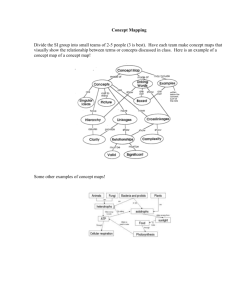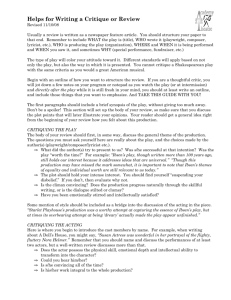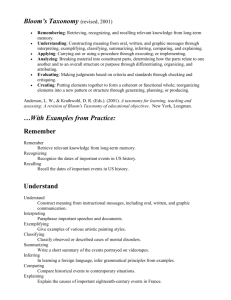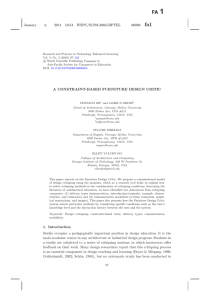DELIVERY TYPES AND COMMUNICATION MODALITIES IN THE FLAT-PACK FURNITURE DESIGN CRITIC
advertisement
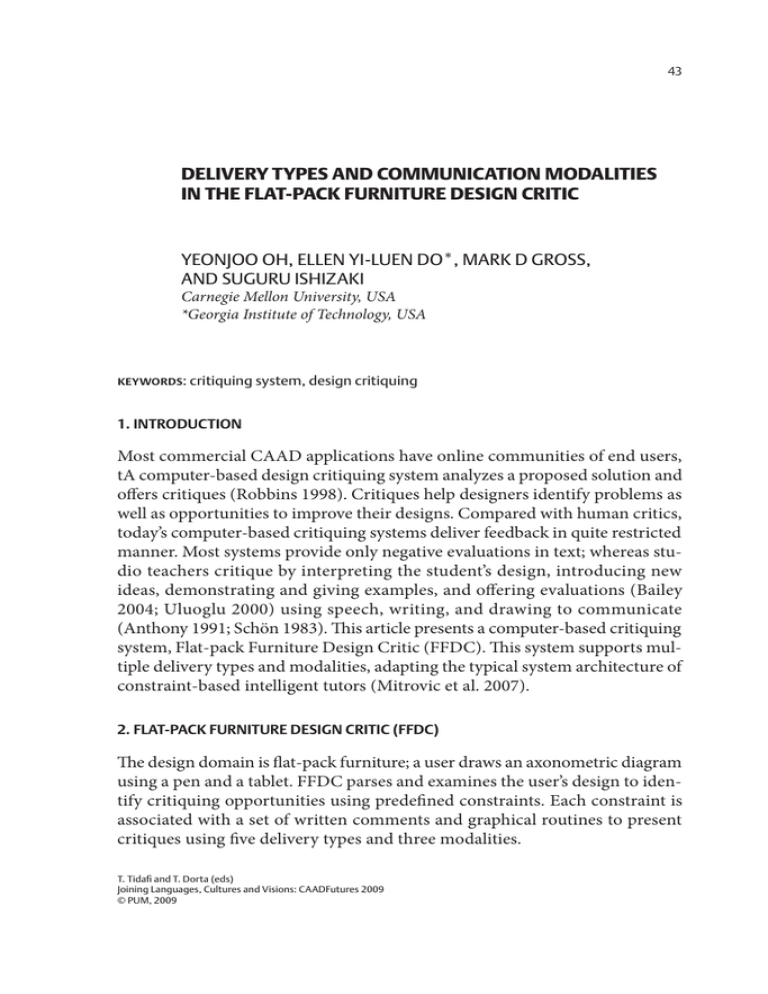
43 DELIVERY TYPES AND COMMUNICATION MODALITIES IN THE FLAT-PACK FURNITURE DESIGN CRITIC YEONJOO OH, ELLEN YI-LUEN DO*, MARK D GROSS, AND SUGURU ISHIZAKI Carnegie Mellon University, USA *Georgia Institute of Technology, USA keywords: critiquing system, design critiquing 1. INTRODUCTION Most commercial CAAD applications have online communities of end users, tA computer-based design critiquing system analyzes a proposed solution and offers critiques (Robbins 1998). Critiques help designers identify problems as well as opportunities to improve their designs. Compared with human critics, today’s computer-based critiquing systems deliver feedback in quite restricted manner. Most systems provide only negative evaluations in text; whereas studio teachers critique by interpreting the student’s design, introducing new ideas, demonstrating and giving examples, and offering evaluations (Bailey 2004; Uluoglu 2000) using speech, writing, and drawing to communicate (Anthony 1991; Schön 1983). This article presents a computer-based critiquing system, Flat-pack Furniture Design Critic (FFDC). This system supports multiple delivery types and modalities, adapting the typical system architecture of constraint-based intelligent tutors (Mitrovic et al. 2007). 2. FLAT-PACK FURNITURE DESIGN CRITIC (FFDC) The design domain is flat-pack furniture; a user draws an axonometric diagram using a pen and a tablet. FFDC parses and examines the user’s design to identify critiquing opportunities using predefined constraints. Each constraint is associated with a set of written comments and graphical routines to present critiques using five delivery types and three modalities. T. Tidafi and T. Dorta (eds) Joining Languages, Cultures and Visions: CAADFutures 2009 © pum, 2009 44 Y. OH • E. Y.-L. DO, M. D. GROSS • S. ISHIZAKI In order to determine which delivery type and modality to use for critiquing, the system maintains a model of the user. This user model represents (1) the history of violated and satisfied constraints, (2) previously used delivery types and modalities, and (3) the furniture parts that are relevant to the violated constraints. FFDC’s Pedagogical Module selects a specific pair of delivery type and modality by considering data from the user model (e.g., how many times a particular constraint is violated and what critiquing methods have already been used). The first time a user violates a specific constraint, the program selects interpretation (delivery type) and written comments (modality). The second time the user violates the same constraint, the system selects introduction and graphical annotations. Once a specific pair of delivery type and modality is selected, the system uses appropriate rendering module to deliver feedback. Figure 1 shows two example critiques presented in the following critiquing methods: introduction and demonstration (delivery types) and written comments and graphical annotation (modalities). figure 1. (1) introduction – the system suggests adding armrests for the chair; and (2) demonstration – the system shows adding a back part to strengthen the bookcase DELIVERY TYPES AND COMMUNICATION MODALITIES 45 REFERENCES Anthony, KH: 1991, Design Juries on Trial: the Renaissance of the Design Studio, New York, Van Nostrand Reinhold. Bailey, RON: 2004, The Digital Design Coach: Enhancing Design Conversations in Architecture Education, PhD dissertation, Architecture Victoria University of Wellington Mitrovic, A, Martin, B and Suraweera, P: 2007, Intelligent Tutors for All: The ConstraintBased Approach. IEEE Intelligent Systems, 22(4): 38 - 45. Robbins, JE: 1998, Design Critiquing Systems. Tech Report UCI-98-41. Department of Information and Computer Science, University of California, Irvine. Schön, DA: 1983, The Reflective Practitioner: How Professionals Think in Action Basic Books Inc. Uluoglu, B: 2000, Design Knowledge Communicated in Studio Critiques Design Studies, 21(1): 33 – 58
